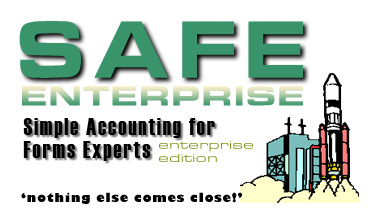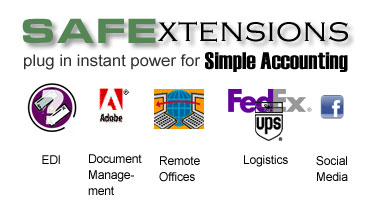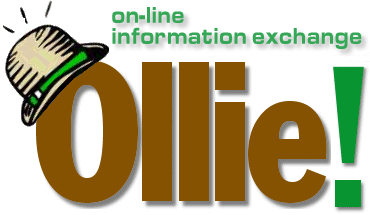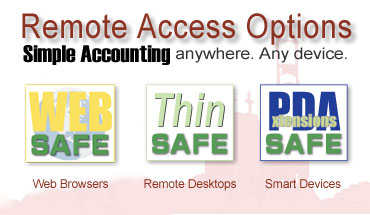 All printing in Simple Accounting is carried out in a similar manner. You will find that you have a lot of control over each report, and this power is very easy to use.
All printing in Simple Accounting is carried out in a similar manner. You will find that you have a lot of control over each report, and this power is very easy to use.
Most reports and forms are generated by pressing the [Print] button in a window; usually from a browse. For example, you print customer invoices from the Sales Orders Browse and you usually print A/P checks from the A/P Bills Browse. This is called context sensitive printing: that is, where you are in Simple Accounting determines what type of report or form will generate when you press the [Print] button.
If you don’t know exactly where to go to print a report or form you need, go to the browse which holds the data you need to report on—the report or form is probably there.
How Reports and Forms Are Structured
Both forms and reports consist of three basic elements:
| Data Source | The data source is determined by where you are in Simple Accounting. As we just said, most reports are launched from a browse window so the report you print takes that browse as its data source. |
| Query | This refers to the order in which records print (the sort) and which records will print (the filter). Collectively, the sort and filter options for a report are known as a Query. Both the sort and the filter are either pre-determined or selected using a Query Window which will automatically appear. A great plus is that you can save your queries for immediate recall whenever you need to run the report. |
| Report Layout | This is the name of the report when you select from the menu. It consists of the fields, headings, footers and totals that print on the report. The layout also determines the reports dimensions (portrait, landscape).
There are two main types of printed copy in Simple Accounting: Forms and Reports.
Forms: Labels, Envelopes, Invoices, Checks, Statements, Purchase Orders, etc. Reports: Lists of things, such as customers, commissions, bills to be paid. Many of the functions discussed here are common to both. The key difference between the two is that Reports are hard-coded into Simple Accounting and cannot be modified. Forms, on the other hand, can be customized to fit your company’s specific needs using our Forms Design Service. Report HeadersThe top, or Header of each report page will always look similar to this:
PG # 1 Customer Aging Sheet Sorted By Company ID MOD: RMLAGE JOHN HAMILTONS CUSTOMERS ======================================================= The information presented on the Report Header will always contain:
Report FootersEvery report also has a footer with a grand total line. The information presented on the Report Footer will always contain:
|
Print Options
This window appears just before printing all reports and forms. It lets you control many aspects of the output. You’ll notice that some options are specific to Reports and some to Forms as indicated next to each with an ‘R’ or an ‘F’:
| Printer Select | Select which printer to use for this report or form. If you have print-preview enabled, the report first appears on screen. | |||||||
| Number of Copies | On most reports and forms you can specify up to 99 copies of the report.
Simple Accounting remembers the number of copies you print for a particular form and the printer you are using if you have SAVE FORM SETTINGS enabled in User Options. These selections are saved and become the default for this form the next time you print the same form! This means that the next time you print a particular form or report, the last printer destination will be automatically selected for you. This makes it easy to use different printers for different tasks. |
|||||||
| R | Include Detail | Unchecking this box hides all detail lines, leaving only headers, subtotals and total sections. This can be useful for creating short summary reports. | ||||||
| R | First Subtotal | Check this option to get subtotals on the report every time the value of the first Sort Option changes. | ||||||
| R | New Page After First Subtotal | Check this option to start a new page after each subtotal prints.
This gives you in effect a new report for each subtotal. The page counter resets to 1 after each subtotal. |
||||||
| R | Second Subtotal | On some reports you can have a secondary subtotal. If your query has a second SortOption, the second subtotal will occur each time this value changes. For example, you might print a sales history report sorted by Employee ID and Product Type. In that case, the first subtotal would be on Employee ID and the second subtotal would be on Product Type giving you a subtotal within each Employees records on Product Type. | ||||||
| R | New Page After Second Subtotal | Starts a new page after the Second Subtotal resets. | ||||||
| R | Print Bare | Print only detail information, with no column, page header or total sections. This is great if you print reports to pre-printed forms, or export data and don’t want to have to edit the file to remove page numbers, headers and so on. | ||||||
| R | Print Even If No Records Found | Occasionally you may wish to indicate that the report actually was printed, even though no records matched the Query. Selecting this option simply prints the initial Page Header (with Query) and the Total Line to show that there were no matching records. | ||||||
| R | Alert On Completion | Play a standard windows ‘beep’ sound when the report has completed. | ||||||
| F | Print Header | Print your company’s name, address and logo at the top of the page. The default for this checkbox is set in Setup Global Options. | ||||||
| F | Select Records | This option box lets you select which records to print from the current browse. The standard options are:
|
Printer Specific Functions
Simple Accounting fully supports the special capabilities of most printers under Windows. These functions are usually accessible from the Printer Dialog when selecting a printer. The most common of these are duplexing, collation, and bar codes:
| Duplexing | If your printer supports it, you can print on both sides of the page by selecting this option from the Printer Dialog. On some forms (such as A/P checks) this function is automatically turned off by Simple Accounting. |
| Collation | Organizes pages when you print multiple copies. Set Collation on to print a complete copy of the report or form before it begins to print the second copy of the report. Turn collation off, if you want all copies of page number one to print, then all copies of page number two, and so on… |
Print Preview
Print Preview lets you see, on screen, any report before it goes to the printer. The report is spooled to a disk file that contains a graphic of each page. You can toggle this feature on or off by pressing <Ctrl/P>.
Although Print Preview is very convenient and you will probably want to use it often, you may wish to turn this feature off when printing long reports since this feature increases the length of time it will take to print the report. Also, Print Preview requires several megabytes of disk space to store all the pages for long reports.
Print Preview is disabled while printing certain forms or if you are faxing.
PREVIEW OPTIONS
When you preview a report or form, a Toolbar appears at the top of the preview giving you several options. These include:
| Zoom | Use the [+] or [-] buttons to increase or decrease the magnification of the preview image on screen.
You can also use your mouse to perform the same functions: Left click to zoom in and right click to zoom out! |
Save Pages |
This option lets you save your work either as an ASCII file which can be edited or imported into other applications, or as images which can be viewed (but not edited) on other PCs. |
| Save Text File | This saves your report as a single ASCII text file. This format is easily read by many other applications. To do this, simply press the Print To Disk button on the Print Preview toolbar
Printing to a text file removes all formatting information (fonts, lines, etc). |
| Saving Preview Images To Disk | Simple accounting generates the Print Preview images for each page as a separate graphics file in the Windows Metafile (WMF) format. Normally these images are deleted from disk as soon as you are through previewing the report or form, but you can elect to save these images to disk after printing by pressing the [Save Image To Disk] button. |
| E-Mailing Reports And Forms |
Simple accounting lets you automatically e-mail the contents of the report. If you have our PDFExtensions installed, then your report will be e-mailed as an Adobe Acrobat document with all formatting intact. Otherwise, your report will be e-mailed in plain text as if you had pressed the Save Text File button (described above), then pasted that file into your e-mail message.
Now when it comes to destinations, Reports are handled a bit differently than forms. If you are printing a Report, (for example, to send an Income Statement to your accountant for review, or a single Form, then you are prompted for an e-mail address to send to. If you have tagged several records to print multiple forms then the the reports/forms are automatically e-mailed to the e-mail address set in each respective Master. For Customer-based forms such as Invoices, Packing Slips, Acknowledgements and Statements, this would mean that each Customer’s form would be sent to the e-mail address specified in their respective Customer Master. If this is a Vendor-based form, such as a Purchase Order, then each form is e-mailed to the appropriate Vendor using the e-mail address specified in their Vendor Master. For Purchase Orders: If the Products on your Purchase Order have one or more Linked Images, these linked files will be e-mailed as attachments along with your e-mail. |
Cancelling A Print Job
A report may be interrupted at any point during the print cycle by pressing the [Cancel] button. If you cancel a report with print-preview enabled you can still elect to preview the pages which have already generated (but not displayed to the screen.,)
If you are using the Windows Print Manager or a network print spooler, the print job may already be completed (as far as Simple Accounting is concerned, anyway) so you will be unable to cancel the job using the [Cancel] button. If this is the case, try the following:
1. Go to the Taskbar, select Settings, then Printers.
2. Select the printer in question. This will open a browse of active print jobs.
3. Select the Printers menu, then select Pause.
4. Now select Purge All Print Jobs.
5. Click on Pause again to re-enable the printer.
6. Close the Printers window and return to Simple Accounting.
Errors During Printing
If an error occurs during printing (If your printer runs out of paper, for example) Windows prompts you to either correct the error or cancel the print job.
Remember that once you hit the [Print] button, certain numbered forms (such as Checks and Customer Invoices) are considered ‘printed’ by Simple Accounting even if they did not actually print. This is referred to as ‘de-spooling’: the print job has been passed from the application (Simple Accounting) to the operating system (Windows) which is then responsible for making sure the printing makes it to the printer. In short: once Windows accepts the job from Simple Accounting, our job is ‘done’.
In the case of A/P Checks and Invoices, this means that the numbering of the transaction occurs before the item is turned into hard copy. If the printer jams, you cannot simply press the [Print] button again as Simple Accounting has already generated unique numbers for those items. In this case, you will need to Void the print run as described in the appropriate topics.
Custom Forms And Reports
The standard forms and report formats included with this module are suitable for use with most printers using plain paper. Many of these are properly formatted to work with your letterhead simply by unchecking the Print Company Header box in the Print Options Window.
You may also order other forms from us, either one of the pre-printed forms that have already been designed to work with this module, or custom forms and reports designed especially for you. Simple Accounting can be set up to print to almost any continuous or sheet-fed forms you select, and in fact, most customers utilize this capability.



